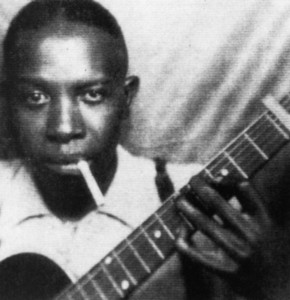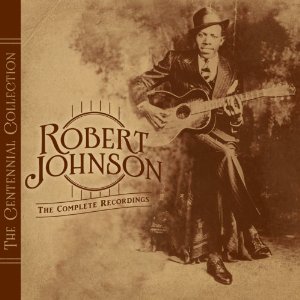(For the remainder of the month, I’ll be revisiting some personal favorites, all of which are available in my recently-released collection, MURPHY’S LAW VOL. ONE, which is available NOW!)
Does any single figure loom as large over an art form as Robert Johnson?
Bach and Shakespeare come to mind, but classical music, like literature, took centuries and multiple cultures in order to unfold and evolve.
The history of American popular music came to be dominated by rock and roll, which initially flowered as a (mostly white) appropriation of the blues. The blues was the common language and unifying force of all rock’s earliest practitioners, many of whom were obsessed with the music made in the first part of the 20th century. It’s well documented that most of the artists from what came to be called the British Invasion were inspired and driven by the example of blues legends like Muddy Waters and Howlin’ Wolf. Put simply, the one individual who even those masters must be measured against, in terms of influence and innovation, is Robert Johnson.
Perhaps the most effective way of getting a handle on Johnson’s unshakable impact is to consider the number of his songs covered by other musicians. Even a listener more than casually acquainted with rock (and blues) history is likely to underestimate how many compositions—popularized by other rock (and blues) musicians spanning several decades—were originally written and recorded by Johnson over the course of a mere seven months in 1936 and 1937.
That he died so young, under sketchy circumstances (allegedly poisoned by the jealous husband of one of his many lovers), leaving behind less than two total hours of recorded music, and being in possession of impossible-sounding guitar skills and a voice no one has ever equaled naturally, perhaps inevitably, led folks to conclude larger forces were at work. Larger in this case meaning evil. As spurious, even silly as that sounds to modern ears, this was an era where anything other than music sung in church might be referred to as “Devil’s music”. In fact, the aforementioned Howlin’ Wolf is only one of myriad geniuses whose decision (as if men like Wolf had any choice) to pursue a musical calling alienated—or ended—close personal and familial relations; in Wolf’s case, his mother, who never spoke to him again.
Of course, there are more than a handful of sociological elements at play in this particular legend. Not unlike Shakespeare, whom many reputable scholars refuse to believe composed all the works he is credited with creating, there were undoubtedly some folks who refused to fathom that a man in his mid-20s could possibly accomplish what Johnson did, in fact, achieve. That there are racial (and racist) elements in play scarcely warrants elaboration. Mostly, humans have been creating legends to explain the inexplicable, whether it involves cave drawings or gods on top of mountains or Faustian deals made with the prince of darkness.
Back in those days, spinning records backwards was neither possible nor necessary. It didn’t require elaborate, if silly stratagems to try and decipher the hidden codes because the lyrics themselves came right out and acknowledged—or alluded to—what certain people suspected. These song titles alone serve as signposts for anyone ready to believe, or instigate, some controversy: “Hell Hound on My Trail”, “Me and the Devil Blues”, “Last Fair Deal Gone Down” and, of course, “Cross Road Blues”. That Robert Johnson met and made a deal with the devil, being granted immortality in exchange for his soul, is one of the enduring, if clichéd folk tales in American musical history.
Here are the facts. Robert Johnson was born May 8, 1911 in Hazlehurt, Mississippi. He worked diligently to develop his skills and cultivate a style, initially emulating (and imitating) fellow legends Son House, Charlie Patton and Willie Brown (who gets a shout out in “Cross Road Blues”). In short order (too short for comfort, according to the conspiracy-minded) Johnson began to attract enough attention to become a fixture throughout his home state and into Tennessee. At the same time he steadily gained a (bad) reputation as the most incorrigible of ladies men. In 1936 he entered a studio in San Antonio and laid down the tracks that continue to cast a shadow over everything else everyone else has ever done. In 1938, he was served a drink that was poisoned, probably by an angry husband, and he died at 27. His beatification was neither immediate nor overwhelming: it took decades of highly regarded players performing and name-checking his material for consensus to inexorably emerge. Robert Johnson belongs in a category unto himself.
And so Johnson remains a figure who almost everyone knows even if not that many people really know him. Sales of his various compilations have certainly sold well enough, but one suspects many people come by his work the same way they encounter Shakespeare: through other artists’ interpretations. This is okay; indeed it speaks volumes about the persistence of his legacy. Nevertheless, considering how incendiary—and consistently satisfying—the source material is, now is as good a time as any to encourage anyone and everyone to get intimately acquainted with the man Eric Clapton insists is “the most important blues singer that ever lived”. In fact, Keith Richards and Jimmy Page (making this three guitarists who have collectively influenced more aspiring musicians than could be counted) all concur that Robert Johnson is the Alpha and the Omega, and who would argue with them?
In preparation for his centennial, Sony/Legacy has produced an attractive, affordable and essential two-CD set compiling the original San Antonio (’36) and Dallas (’37) recordings, along with more than a dozen alternate takes. The package is near-perfect, with extensive liner notes, photos and most crucially, radically improved sound. For anyone, like this writer, who has the old Complete Recordings edition (the original Holy Grail), the sound on these discs is revelatory. Certainly, there is no disguising the fact that these are old recordings, produced by antiquated means, and that dusty authenticity is impossible to disguise (thank goodness). On the other hand, many of the hisses, shifts in volume and other distracting elements from previous incarnations have been lovingly minimized. This is worth picking up even if you are completely satisfied with whatever recording you currently own; in fact you owe it to yourself to hear the difference.
Is there anything else that needs to be said? It’s always enlightening to hear the unfiltered first takes on masterpieces like “Sweet Home Chicago”, “From Four Until Late”, “Traveling Riverside Blues” and “Love in Vain Blues”. As anyone who knows can attest, this is not remotely music for a museum, relics to acknowledge before moving on. It is exciting, joyful noise, brimming with purpose and ingenuity, fun and frightening, enigmatic and awe-inspiring. And once again, it is remarkable to consider the diversity of artists who have been drawn to these touchstones, and our musical heritage is incalculably richer for all of the faithful and unconventional “cover songs” Johnson unknowingly commissioned.
One more thing needs to be said. T.S. Eliot wrote that “humankind cannot bear very much reality”. The reality is this: there was no deal with the devil; there was no devil. There was one man, one guitar and one abiding legend. That legend grows in direct proportion to our capacity to come fully to grips with how influential—and unbelievable—Robert Johnson remains.


